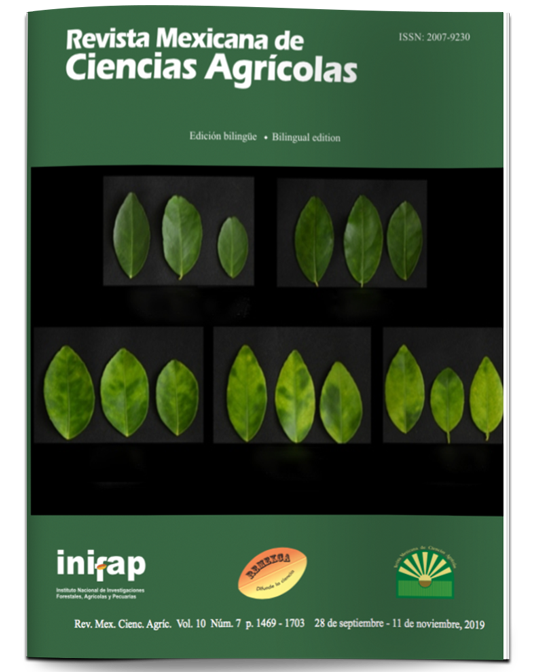Tomato-associated phytophagous mites in northern Sinaloa, Mexico
DOI:
https://doi.org/10.29312/remexca.v10i7.1756Keywords:
Phytonemus pallidus, Polyphagotarsonemus latus and Tetranychus urticae, shadow meshAbstract
Due to the great importance that Sinaloa has in the production of red tomato in Mexico, the need arose to carry out the present investigation whose objective was to determine the species of phytophagous mites associated with tomato cultivation in the north of Sinaloa and to know their population fluctuation. The work was carried out in the north of the state, in four sampling sites and two production systems (shade mesh and open field). Sampling was carried out on a biweekly basis during the period from December 2015 to May 2016, randomly 10 plants per plot were selected and 30 leaflets per plant, 10 per stratum (upper, middle and lower) were considered as the sampling unit. 1 548 mites in shade mesh and 1 314 in open field were collected, of the total mites collected, 71.5% corresponded to Tetranychus urticae, 13.2% to Polyphagotarsonemus latus and 15.3% to Phytonemus pallidus. The T. urticae species was present during all stages of crop development, its population fluctuation fluctuated according to temperature conditions, with lower presence records during January-February and higher incidence during April-May. The presence of the cyclamen mite, Phytonemus pallidus in the shade mesh production system during the reproductive stage of the crop represents the first record of the presence of this species on the crop in northern Sinaloa.
Downloads
Published
How to Cite
Issue
Section
License
The authors who publish in Revista Mexicana de Ciencias Agrícolas accept the following conditions:
In accordance with copyright laws, Revista Mexicana de Ciencias Agrícolas recognizes and respects the authors’ moral right and ownership of property rights which will be transferred to the journal for dissemination in open access. Invariably, all the authors have to sign a letter of transfer of property rights and of originality of the article to Instituto Nacional de Investigaciones Forestales, Agrícolas y Pecuarias (INIFAP) [National Institute of Forestry, Agricultural and Livestock Research]. The author(s) must pay a fee for the reception of articles before proceeding to editorial review.
All the texts published by Revista Mexicana de Ciencias Agrícolas —with no exception— are distributed under a Creative Commons License Attribution-NonCommercial 4.0 International (CC BY-NC 4.0), which allows third parties to use the publication as long as the work’s authorship and its first publication in this journal are mentioned.
The author(s) can enter into independent and additional contractual agreements for the nonexclusive distribution of the version of the article published in Revista Mexicana de Ciencias Agrícolas (for example include it into an institutional repository or publish it in a book) as long as it is clearly and explicitly indicated that the work was published for the first time in Revista Mexicana de Ciencias Agrícolas.
For all the above, the authors shall send the Letter-transfer of Property Rights for the first publication duly filled in and signed by the author(s). This form must be sent as a PDF file to: revista_atm@yahoo.com.mx; cienciasagricola@inifap.gob.mx; remexca2017@gmail.
This work is licensed under a Creative Commons Attribution-Noncommercial 4.0 International license.



